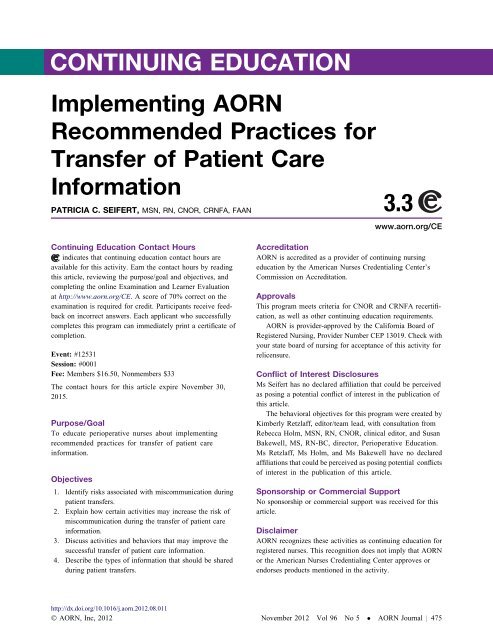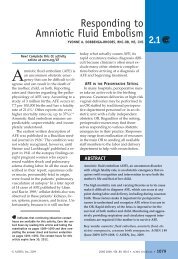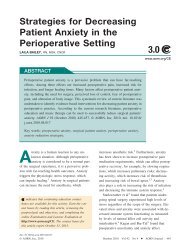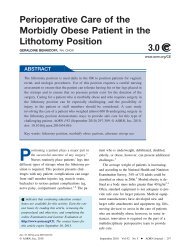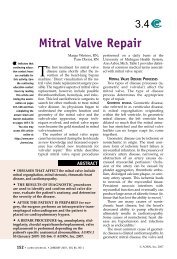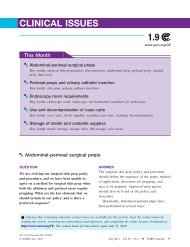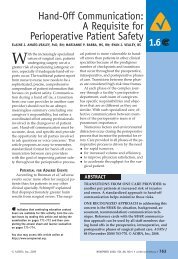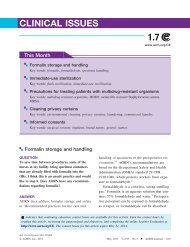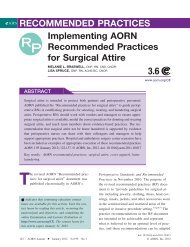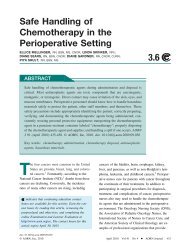Implementing AORN Recommended Practices for Transfer of Patient ...
Implementing AORN Recommended Practices for Transfer of Patient ...
Implementing AORN Recommended Practices for Transfer of Patient ...
You also want an ePaper? Increase the reach of your titles
YUMPU automatically turns print PDFs into web optimized ePapers that Google loves.
November 2012 Vol 96 No 5 SEIFERTsupport the need <strong>for</strong> evidence-based practices toreduce communication errors.<strong>AORN</strong> and The Joint Commission both recommenda standardized and comprehensive approachto patient transfers. Some commonly recognizedareas involving patient transfers include from anursing unit to the OR; from a cardiac catheterizationlaboratory, interventional radiology suite,or other interventional suite to the OR; from anambulatory surgery center to a nursing home ora nursing home to an ambulatory surgery center;and from the OR to the postanesthesia care unit(PACU) or intensive care unit (ICU). In<strong>for</strong>mationtransfer also takes place in the surgical schedulingdepartment or the preanesthesia testing unit wheninstructions are given to the patient. Through its“Hand Off Communications Project,” The JointCommission suggests a program known by theacronym SHARE. 5 The program demonstrateswhich elements the accrediting agency will auditand score. <strong>Recommended</strong> behaviors and someexamples from the SHARE project includethe following:nnnnS e Standardize critical content.n Provide details about the patient’s history tothe receiver.n Synthesize in<strong>for</strong>mation received fromseparate sources be<strong>for</strong>e passing it on to thereceiver.H e Hardwire behaviors within your system.n Develop standardized <strong>for</strong>ms, checklists, andother tools.n State expectations <strong>for</strong> a successful hand <strong>of</strong>f.A e Allow the opportunity to ask questions.n Share and receive in<strong>for</strong>mation as an interdisciplinaryteam.n Scrutinize and question the data and exchangecontact in<strong>for</strong>mation with the senders in casefollow-up is needed.R e Rein<strong>for</strong>ce quality and measurement.n Monitor compliance with the use <strong>of</strong> standardized<strong>for</strong>ms.n Use data to drive process improvement.nE e Educate and coach.n Standardize the training <strong>for</strong> successful hand<strong>of</strong>fs.n Make successful hand <strong>of</strong>fs an organizationalpriority.Other transfer periods also exist wherein communicationbetween patients and health care representativesmay be insufficient or patients maynot understand or may fail to comply with preoperativeorders. It is not uncommon, <strong>for</strong> example, tohave patients arrive at the site <strong>of</strong> surgery later thanthe recommended time without having taken theprescribed antiseptic shower or after having eatenbreakfast. The consequences <strong>of</strong> not adhering to (orfailing to understanding) the preoperative instructionsmay be as relatively inconsequential as adelay in the start <strong>of</strong> the surgery or as serious ascancellation <strong>of</strong> the surgery. A patient’s failure tounderstand or to adhere to the instructions fromstaff members at the surgeon’s <strong>of</strong>fice or frompersonnel in the preanesthesia testing unit, wherelaboratory tests may have been per<strong>for</strong>med withina few days be<strong>for</strong>e surgery, represents an additionaltransfer point that can affect the patient’s outcome.The potential <strong>for</strong> patients to misunderstand ornot follow recommendations should alert perioperativeclinicians to engage in strategies that educateboth patients and colleagues (eg, surgeon’s<strong>of</strong>fice staff members who provide preoperativeinstructions to patients) to rein<strong>for</strong>ce the importance<strong>of</strong> following the prescribed preoperative activities.The solution may be as simple as having a meetingwith <strong>of</strong>fice personnel to review not only the instructions(eg, antiseptic shower, leaving valuablesat home, remaining NPO), but also the rationale <strong>for</strong>them. Improved communication between perioperativeclinicians and <strong>of</strong>fice staff members canimprove working relationships and help patientsachieve optimal outcomes. Consistency and reliabilityare hallmarks that can be improved withimplementation <strong>of</strong> the <strong>AORN</strong> practice recommendationsand the use <strong>of</strong> other <strong>AORN</strong> resources,notably <strong>AORN</strong>’s <strong>Patient</strong> Hand Off Tool Kit. 9478 j <strong>AORN</strong> Journal
RP IMPLEMENTATION GUIDE: TRANSFER OF CAREwww.aornjournal.orgDISCUSSIONThe following discussion addresses <strong>AORN</strong>’s practicerecommendations <strong>for</strong> the transfer <strong>of</strong> care andillustrates how the components <strong>of</strong> the RP documentcan be implemented. Readers should use theirjudgment to determine whether their clinical situationallows adaptation <strong>of</strong> the examples describedhere or whether other methods <strong>of</strong> implementationwould be more suitable. One <strong>of</strong> the key recommendationsis to engage in open, multidisciplinarydiscussions to arrive at procedures and activitiesthat fit the reader’s situation. <strong>AORN</strong>’s <strong>Patient</strong> HandOff Tool Kit 9 can be especially valuable becauseit includes a broad array <strong>of</strong> in<strong>for</strong>mation, sample<strong>for</strong>ms and policies, and references <strong>for</strong> further study.Recommendation I“A transfer <strong>of</strong> patient in<strong>for</strong>mation process shouldbe developed, standardized, and based upon thebest available and most current evidence.” 1(p465) Amultidisciplinary team should develop standardizedcommunication protocols that can be applied acrossthe preoperative, intraoperative, and postoperativephases <strong>of</strong> care to reduce communication errors.<strong>AORN</strong>’s “<strong>Recommended</strong> practices <strong>for</strong> transfer<strong>of</strong> patient care in<strong>for</strong>mation” 1 addresses strategiesto promote effective communication, which is thebasis <strong>for</strong> successful in<strong>for</strong>mation transfers. Thepractice recommendations affect patients and theirfamily members as well as pr<strong>of</strong>essional caregivers.For example, perioperative nurses can use writtenin<strong>for</strong>mation and individualized education relatedto transfers to reduce patient and family memberanxiety. Perioperative personnel can enhance theeffectiveness and accuracy <strong>of</strong> in<strong>for</strong>mation transferby communicating directly with one another, encouragingquestions or clarifying instructions thatare unclear, and using all <strong>for</strong>ms <strong>of</strong> communication(eg, facial expressions, eye contact, body language). 1Multidisciplinary team. Just as effective communicationcan influence positive patient outcomes,so too can caregivers from different departments orpr<strong>of</strong>essions working together. 1 Team leaders (eg,nurse, surgeon, anesthesia pr<strong>of</strong>essional) are valuablerole models when they demonstrate in<strong>for</strong>mationsharing, coordination <strong>of</strong> care, and working togetherto focus on the patient rather than on personal ordepartmental needs. All team members, includingsupport personnel, should be included in the teamand be recognized as bringing important skill sets,special knowledge, and significant experience to thepatient’s care.Standardization. This first recommendationaddresses the importance <strong>of</strong> standardized transferprotocols as a way to reduce or prevent communicationerrors. 10,11 Research has shown thatin<strong>for</strong>mation transfer failures are common in surgicalcare, but when health care providers use standardizedcommunication techniques, such as checklists, theyfacilitate surgical safety by reducing the number <strong>of</strong>communication-related errors. 4,12 In a study by Joyet al 12 that involved using a standardized checklist,technical errors were reduced from 6.24 to 1.52 (P
November 2012 Vol 96 No 5 SEIFERTFigure 1. A checklist is a standardized communication tool that can be used be<strong>for</strong>e the start <strong>of</strong> surgery to ensurethe handover <strong>of</strong> critical in<strong>for</strong>mation.reflects the patient’s needs. For example, nursesreceiving a patient in the PACU would want in<strong>for</strong>mationfrom the OR including the patient’sname, the title <strong>of</strong> the surgical procedure, the patient’shemodynamic status, the type <strong>of</strong> anesthesia,and any allergies. 1 When creating the <strong>for</strong>m, nursesfrom the OR and PACU would collaborate tospecify what in<strong>for</strong>mation is available to the senderand needed by the receiver. The sending nurse inthe OR would complete the <strong>for</strong>m with the requiredin<strong>for</strong>mation be<strong>for</strong>e transporting the patient to thePACU, and the receiving nurse in the PACU wouldwrite down the in<strong>for</strong>mation on a duplicate <strong>for</strong>m.This process reduces the risk <strong>of</strong> omitting in<strong>for</strong>mation.It is also easier to notice and correct gapsin the in<strong>for</strong>mation when both the sending andreceiving nurses use the same <strong>for</strong>m.In addition to The Joint Commission’s SHAREprocess, 5 other communication techniques <strong>for</strong>perioperative nurses are illustrated in the <strong>AORN</strong>RP document and the <strong>AORN</strong> <strong>Patient</strong> Hand OffTool Kit. 9 These techniques standardize the in<strong>for</strong>mationthat should be included in hand-<strong>of</strong>f reports.Standardized communication and documentationtechniques may be used in the written recorditself and also can be used to communicate verballywith a colleague. The RP document liststhe following <strong>for</strong>mats:n SBAR: situation, background, assessment,recommendation 16n I PASS the BATON: introduction, patient,assessment, situation, safety concerns, (the)background, actions, timing, ownership, next 17n SURPASS: SURgical PAtient Safety System 18n SHARED: situation, history, assessment,request, evaluate, document. 19We applied the SBAR technique to a cardiovascularOR transfer report at my facility (Figure 2).Preoperative phase. A preoperative <strong>for</strong>mshould be used and made available both to preoperativeand intraoperative caregivers. Often, it isthe patient’s circulating nurse who reviews thein<strong>for</strong>mation on the preoperative <strong>for</strong>m and discussesits contents with the patient, preoperative nurse,surgeon, anesthesia pr<strong>of</strong>essional, and other members<strong>of</strong> the team who are involved in the patient’s care.For example, site marking should be noted on the480 j <strong>AORN</strong> Journal
November 2012 Vol 96 No 5 SEIFERTnnnnmonitoring line types (eg, electrocardiogram,arterial blood pressure line) and locations (eg,right radial artery, left upper arm),specimens (eg, type, number, location, testsrequested),whether there are special needs (eg, child withautism), andfamily member or patient concerns or fears (eg,the patient is embarrassed by lack <strong>of</strong> dentures).At the completion <strong>of</strong> surgery, but be<strong>for</strong>e transportingthe patient to the receiving unit, the surgeonmay per<strong>for</strong>m a debriefing, 22 which could includewhat went well during the procedure, what could beimproved, and other concerns or comments.Postoperative phase. During the postoperativephase, the following in<strong>for</strong>mation should be includedin the communication to the receiving unit:n patient verification;n procedure per<strong>for</strong>med;n allergies;n hemodynamic status;n ventilator settings;n medications (eg, being given through the IVline);n urine output;n dressings, tubes, and drains (eg, type, location);n surgeon’s orders (eg, drains, diet, medications);n complications; andn standard precautions taken <strong>for</strong> infectionprevention.Additional transfer reports depend on the clinicalenvironment (eg, ambulatory or hospital setting),the patient’s acuity, any identified safety risks (eg,presence <strong>of</strong> neurological or physical deficits), andthe clinicians who are involved. 1,18,29 In<strong>for</strong>mationshared on transfer to an inpatient nursing unitwould include the postoperative transfer components,but if the patient were in the ambulatorysetting and scheduled to be discharged, the transferin<strong>for</strong>mation also would include discharge instructions,possible complications, and whom to call <strong>for</strong>help. The numerous possible transfer scenarios thata patient may undergo rein<strong>for</strong>ce the recommendederror-prevention strategies <strong>of</strong> standardizing in<strong>for</strong>mationprocesses, using them within a multidisciplinaryteam, and using active communicationtechniques (Figure 3). 1Recommendation II“<strong>Patient</strong>s, families, and significant others shouldhave an active role in transfer <strong>of</strong> patient in<strong>for</strong>mationprocesses whenever possible.” 1(p468) Reducinganxiety is an important aspect <strong>of</strong> patient care becausepatients and their significant others andfamily members may be anxious about surgery(Figure 4). Nurses should be actively involved intransfer processes whenever possible. When nursesprovide a structured and individualized transferprocess that engages patients and their familymembers, they can help reduce family members’anxiety. 1,30,31Nurses may employ a variety <strong>of</strong> communicationmethods that can be used with waiting familymembers. These may include calling the waitingarea and talking with family members, going onrounds (ie, rounding) in the waiting area to talk t<strong>of</strong>amily members in person, and providing writtenin<strong>for</strong>mation. Written, individualized in<strong>for</strong>mationabout transfers given to relatives and friends alsohas been shown to decrease anxiety. 32,33 Engagingthe patient and others also can be achieved withindividualized and structured transfer methods,such as providing education a few days be<strong>for</strong>esurgery. This helps with retention <strong>of</strong> in<strong>for</strong>mationbecause higher anxiety levels, as in the immediatepreoperative period, can reduce retention. Preoperativetours <strong>for</strong> children and their parents are alsovaluable <strong>for</strong> promoting in<strong>for</strong>mation retention andcan enhance the entire perioperative period <strong>for</strong> thepatient and his or her family members.The Final FourThe final four recommendations in each <strong>AORN</strong>RP document discuss education/competency, documentation,policies and procedures, and qualityassurance/per<strong>for</strong>mance improvement. These four484 j <strong>AORN</strong> Journal
RP IMPLEMENTATION GUIDE: TRANSFER OF CAREwww.aornjournal.orgpatient advocacy because being proactive and notbeing pushed to rush is consistent with betterpatient outcomes, like minimizing or eliminatingthe risk <strong>of</strong> surgery on the wrong eye.HOSPITAL PATIENT SCENARIONurse L is in charge <strong>of</strong> a 10-room OR on a Saturdaymorning. She receives a call from the emergencydepartment (ED) charge nurse that a patient witha traumatic subtotal transection <strong>of</strong> a thumb isscheduled to arrive in the ED within 30 minutes. TheED charge nurse states that the hand surgeon, Dr N, ison the way to the ED and wants to transport thepatient immediately to the OR <strong>for</strong> repair and reattachment<strong>of</strong> the thumb. Nurse L asks and is told thatthe patient’s right hand is affected. The ED chargenurse gives Nurse L additional available in<strong>for</strong>mation,including the patient’s name, age, and allergies.Nurse L requests that the ED nurse or her designatepage her immediately when the patient arrives, andshe confirms that there are sufficient ED personnelto transport the patient to the OR.Nurse L pages Dr N and discusses the preliminaryplan using the SBAR <strong>for</strong>mat:n the situation is that there is a traumatic injury tothe patient’s right thumb, which requires repair;n the background is that the patient had a caraccident during which he suffered the thumbinjury;n the assessment is that the surgical repair must beper<strong>for</strong>med as quickly as possible to minimizethe possibility <strong>of</strong> irreparable harm to theviability <strong>of</strong> the thumb; andn the recommendation is to per<strong>for</strong>m reparativesurgery as promptly as possible.Nurse L asks about the planned surgical procedureand any special instrumentation that may be needed,and Dr N describes the proposed surgery and liststhe special items that he needs. Nurse L writesdown the surgeon’s cell phone number and lets himknow that she will call him shortly with an update.Nurse L contacts the anesthesia pr<strong>of</strong>essional andreports the plan.Nurse L calls the sterile processing departmentand requests that a case cart <strong>for</strong> hand surgery withDr N’s specially requested items be brought to theOR as rapidly as possible. Nurse L assesses thecurrent OR schedule and sees that no staff membersare available. She determines that <strong>of</strong> the threerunning procedures, the one in OR 6 is nearingcompletion, so the perioperative team will beavailable immediately after their patient is transferredto the PACU.Nurse L considers the trauma patient’s transferfrom the ED to the OR. For the hand surgery, sheselects OR 8 because the right side <strong>of</strong> the ORbed is parallel to the OR wall and on the oppositeside <strong>of</strong> the OR patient entrance door. In this way,the “ironing board” positioning device <strong>for</strong> hand/arm surgery can be attached to the bed be<strong>for</strong>e thepatient arrives. This will allow the patient to betransferred to the OR bed, the right hand immediatelyplaced on the positioning device, and the lowerright arm and hand promptly prepped and draped.Nurse L then goes to OR 6 where surgery isbeing completed and notifies the circulating nurse.Nurse L asks the circulating nurse to have thesurgical technologist go to OR 8 and set up theprocedure as soon as the current patient leavesthe room en route to the PACU. Nurse L tells thecirculating nurse that she has ordered the instrumentationand will set the instruments and suppliesaround the OR as soon as they arrive. She asks thecirculating nurse to go to OR 8 after transportingher current patient to the PACU and completing herdocumentation.Nurse L calls the surgeon and gives him anupdate on the situation. The case cart arrives a shorttime later, and Nurse L obtains the arm boardpositioning device and brings it and the case cartto OR 8. She sets up the positioning device and setsaround the instrument and supply packs. The surgicaltechnologist arrives in OR 8, and Nurse Lopens the packs while the surgical technologistscrubs. Nurse L ties up the gown <strong>of</strong> the surgicaltechnologist, who prepares the instrumentation.The anesthesia pr<strong>of</strong>essional arrives, followed by<strong>AORN</strong> Journal j 487
November 2012 Vol 96 No 5 SEIFERTthe circulating nurse from OR 6. Nurse L reportsthe most recent in<strong>for</strong>mation available to the team.The ED nurse calls to say that the patient hasarrived and that the surgeon is in the ED assessinghim. The ED nurse also in<strong>for</strong>ms Nurse L that both<strong>of</strong> the patient’s hands were injured in the accidentbut only the right hand requires surgery. Nurse Lreports this to the surgical team. The team is readyto receive the patient, so Nurse L contacts the EDnurse to tell her that the OR is ready. The anesthesiapr<strong>of</strong>essional arrives and prepares <strong>for</strong> induction<strong>of</strong> general anesthesia. Dr N arrives and relaysadditional in<strong>for</strong>mation about the planned surgery.The patient arrives and the circulating nursepromptly identifies the patient. The circulatingnurse notes that both hands are bandaged. Sheinitiates a time out, during which all team membersconfirm the patient and the surgical site. Afterinduction <strong>of</strong> anesthesia, the circulating nurse positionsand preps the affected arm and hand. Thesurgeon succinctly briefs the team and per<strong>for</strong>msa time out be<strong>for</strong>e repairing the injured thumb.After surgery, the anesthesia pr<strong>of</strong>essional and circulatingnurse transport the patient to the PACU.A few days later, the surgeon in<strong>for</strong>ms the perioperativeteam that the repaired thumb is movingand seems to be healing appropriately. Dr N tellsthe team that their efficient and timely preparationmade an important difference and resulted in thesuccessful outcome <strong>of</strong> the surgery.This transfer from ED to OR was facilitated byproactive communication, anticipation, and criticalResources <strong>for</strong> Implementationn <strong>AORN</strong> Nurse Consult Line (800) 755-2676 or (303) 755-6300.n ORNurseLink. http://www.aorn.org/ORNurseLink.n Perioperative Job Descriptions and Competency EvaluationTools [CD-ROM]. http://www.aorn.org/JobDescriptions.n Ambulatory Surgery Center Resources [CD-ROM]. http://www.aorn.org/AmbulatorySurgeryCenterResources.Web site access verified August 8, 2012.thinking, and it serves as a positive example <strong>of</strong>what can happen when nurses are capable <strong>of</strong> seeinga picture larger than their own unit. The teamfollowed the basic hand-<strong>of</strong>f recommendations <strong>for</strong>direct communication using a standardized <strong>for</strong>mat(eg, SBAR), collaborated across disciplines anddepartments, and verified critical factors (eg, patientidentity, correct site), which facilitated anoptimal outcome.This scenario highlights some challenges associatedwith trauma patients coming to an OR froma location outside the hospital. In these situations,clinicians cannot always rely on recommended interventionsthat make use <strong>of</strong> face-to-face exchangesand opportunities <strong>for</strong> extensive dialogue. Given thetime constraints associated with trauma or emergencyprocedures, perioperative nurses must usethe available resources. Among these are the collaborativerelationships established among andbetween clinicians in various departments <strong>of</strong> ahealth care organization. Such relationships arethe foundation <strong>of</strong> good communication, which inturn is the foundation <strong>for</strong> optimal patient care.CONCLUSION<strong>AORN</strong>’s “<strong>Recommended</strong> practices <strong>for</strong> transfer <strong>of</strong>patient care in<strong>for</strong>mation” affects most aspects <strong>of</strong>perioperative patient care because the communication<strong>of</strong> in<strong>for</strong>mation underlies so many patientcare activities. Key recommendations includestandardizing communication processes and techniquesto avoid communication failures; workingwith colleagues from all relateddisciplines; using bothverbal and written communication;encouraging allteam members to ask questions;developing patienttransfer protocols; and activelyincluding the patientand his or her family membersand significant othersin the communication processes.Because effective488 j <strong>AORN</strong> Journal
November 2012 Vol 96 No 5 SEIFERTintensive care unit: the development and evaluation<strong>of</strong> an in<strong>for</strong>mation booklet. J Clin Nurs. 2004;13(3):396-405.33. Tel H, Tel H. The effect <strong>of</strong> individualized educationon the transfer anxiety <strong>of</strong> patients with myocardial infarctionand their families. Heart Lung. 2006;35(2):101-107.34. Perioperative Job Descriptions and Competency EvaluationTools [CD-ROM]. Denver, CO: <strong>AORN</strong>, Inc; 2012.35. Policy and Procedure Templates. 2nd ed [CD-ROM].Denver, CO: <strong>AORN</strong>, Inc; 2010.Patricia C. Seifert, MSN, RN, CNOR, CRNFA,FAAN, is a staff nurse in the CardiovascularOperating Room, Inova Heart and VascularInstitute, Falls Church, VA. Ms Seifert has nodeclared affiliation that could be perceived asposing a potential conflict <strong>of</strong> interest in thepublication <strong>of</strong> this article.This RP Implementation Guide is intended to be an adjunct to the complete recommended practices document uponwhich it is based and is not intended to be a replacement <strong>for</strong> that document. Individuals who are developing andupdating organizational policies and procedures should review and reference the full recommended practicesdocument.490 j <strong>AORN</strong> Journal
EXAMINATIONCONTINUING EDUCATION PROGRAM<strong>Implementing</strong> <strong>AORN</strong> <strong>Recommended</strong><strong>Practices</strong> <strong>for</strong> <strong>Transfer</strong> <strong>of</strong> <strong>Patient</strong> CareIn<strong>for</strong>mation3.3www.aorn.org/CEPURPOSE/GOALTo educate perioperative nurses about implementing recommended practices <strong>for</strong>transfer <strong>of</strong> patient care in<strong>for</strong>mation.OBJECTIVES1. Identify risks associated with miscommunication during patient transfers.2. Explain how certain activities may increase the risk <strong>of</strong> miscommunicationduring the transfer <strong>of</strong> patient care in<strong>for</strong>mation.3. Discuss activities and behaviors that may improve the successful transfer <strong>of</strong>patient care in<strong>for</strong>mation.4. Describe the types <strong>of</strong> in<strong>for</strong>mation that should be shared during patient transfers.The Examination and Learner Evaluation are printed here <strong>for</strong> your convenience.To receive continuing education credit, you must complete the Examinationand Learner Evaluation online at http://www.aorn.org/CE.QUESTIONS1. The Joint Commission has estimated that ___%<strong>of</strong> serious medical errors are associated withmiscommunication during patient hand <strong>of</strong>fs.a. 50 b. 65c. 80 d. 952. The use <strong>of</strong> cellular telephones, pagers, and musicare considered interruptions and distractionsduring the transfer <strong>of</strong> patient care in<strong>for</strong>mation.a. true b. false3. Examples from The Joint Commission’s SHAREproject <strong>of</strong> recommended behaviors that can beused during the transfer <strong>of</strong> patient care in<strong>for</strong>mationinclude1. providing details about the patient’s historyto the receiver.2. developing standardized <strong>for</strong>ms and checklistsand monitoring compliance with their use.3. stating expectations <strong>for</strong> a successful hand <strong>of</strong>f.4. sharing and receiving in<strong>for</strong>mation as aninterdisciplinary team.5. standardizing training <strong>for</strong> successful hand <strong>of</strong>fs.a. 1 and 3 b. 1, 2, and 5c. 2, 3, and 4 d. 1,2,3,4,and54. Perioperative personnel can help promote effectivecommunication and accurate in<strong>for</strong>mationtransfer bya. communicating only with direct supervisors orsubordinates.Ó <strong>AORN</strong>, Inc, 2012 November 2012 Vol 96 No 5 <strong>AORN</strong> Journal j 491
November 2012 Vol 96 No 5 CE EXAMINATIONb. encouraging questions and clarifying instructionsthat are unclear.c. avoiding the use <strong>of</strong> facial expressions and bodylanguage.d. minimizing eye contact during intenseconversations.5. Research has shown that when health care providersuse _________, they facilitate surgicalsafety by reducing communication-related errors.a. checklistsb. Internet resourcesc. text messagingd. telephonic communications6. Forms used to communicate in<strong>for</strong>mation fromone area <strong>of</strong> the health care institution to the othershould be developed by personnel in both thesending and receiving units.a. true b. false7. In<strong>for</strong>mation that should be included on a preoperative<strong>for</strong>m includes1. allergies and medication pr<strong>of</strong>ile.2. advanced directives.3. cultural and spiritual needs <strong>of</strong> the patient.4. planned anesthesia type.a. 1 and 2 b. 3 and 4c. 1, 2, and 3 d. 1, 2, 3, and 48. A standardized <strong>for</strong>m used to verify OR-specificin<strong>for</strong>mation be<strong>for</strong>e the incision is made shouldinclude1. anticipated blood loss and blood productavailability.2. availability <strong>of</strong> special equipment, devices,instruments, and implants.3. deep vein thrombosis prophylaxis.4. urine output.a. 1 and 3 b. 2 and 4c. 1, 2, and 3 d. 1, 2, 3, and 49. Be<strong>for</strong>e completion <strong>of</strong> surgery, patient in<strong>for</strong>mationthat should be reported to the receiving unitincludes1. laboratory test values.2. patient concerns or fears.3. the medications that were given, includingantibiotics.4. the patient’s hemodynamic status and whatmonitoring devices were used.a. 1 and 3 b. 2 and 4c. 1, 2, and 4 d. 1, 2, 3, and 410. Communication methods that may be useful <strong>for</strong>a perioperative nurse to use with a patient’sfamily members include1. going on rounds in the waiting area to talk tothe family members in person.2. providing written, individualized in<strong>for</strong>mationabout transfers.3. providing education a few days be<strong>for</strong>esurgery to help with in<strong>for</strong>mation retention.4. conducting tours <strong>of</strong> the OR <strong>for</strong> children andtheir parents.a. 1 and 3 b. 2 and 4c. 1, 2, and 3 d. 1, 2, 3, and 4492 j <strong>AORN</strong> Journal
LEARNER EVALUATIONCONTINUING EDUCATION PROGRAM<strong>Implementing</strong> <strong>AORN</strong> <strong>Recommended</strong><strong>Practices</strong> <strong>for</strong> <strong>Transfer</strong> <strong>of</strong> <strong>Patient</strong> CareIn<strong>for</strong>mation3.3www.aorn.org/CEThis evaluation is used to determine the extent towhich this continuing education program metyour learning needs. Rate the items as describedbelow.OBJECTIVESTo what extent were the following objectives <strong>of</strong> thiscontinuing education program achieved?1. Identify risks associated with miscommunicationduring patient transfers.Low 1. 2. 3. 4. 5. High2. Explain how certain activities may increase therisk <strong>of</strong> miscommunication during the transfer <strong>of</strong>patient care in<strong>for</strong>mation.Low 1. 2. 3. 4. 5. High3. Discuss activities and behaviors that may improvethe successful transfer <strong>of</strong> patient care in<strong>for</strong>mation.Low 1. 2. 3. 4. 5. High4. Describe the types <strong>of</strong> in<strong>for</strong>mation that should beshared during patient transfers.Low 1. 2. 3. 4. 5. HighCONTENT5. To what extent did this article increase yourknowledge <strong>of</strong> the subject matter?Low 1. 2. 3. 4. 5. High6. To what extent were your individual objectives met?Low 1. 2. 3. 4. 5. High7. Will you be able to use the in<strong>for</strong>mation from thisarticle in your work setting? 1. Yes 2. No8. Will you change your practice as a result <strong>of</strong> readingthis article? (If yes, answer question #8A. If no,answer question #8B.)8A. How will you change your practice? (Select all thatapply)1. I will provide education to my team regardingwhy change is needed.2. I will work with management to change/implement a policy and procedure.3. I will plan an in<strong>for</strong>mational meeting withphysicians to seek their input and acceptance<strong>of</strong> the need <strong>for</strong> change.4. I will implement change and evaluate theeffect <strong>of</strong> the change at regular intervals untilthe change is incorporated as best practice.5. Other: ________________________________8B. If you will not change your practice as a result<strong>of</strong> reading this article, why? (Select all thatapply)1. The content <strong>of</strong> the article is not relevant to mypractice.2. I do not have enough time to teach othersabout the purpose <strong>of</strong> the needed change.3. I do not have management support to makea change.4. Other: ________________________________9. Our accrediting body requires that we verifythe time you needed to complete the 3.3 continuingeducation contact hour (198-minute)program: _________________________________Ó <strong>AORN</strong>, Inc, 2012 November 2012 Vol 96 No 5 <strong>AORN</strong> Journal j 493


